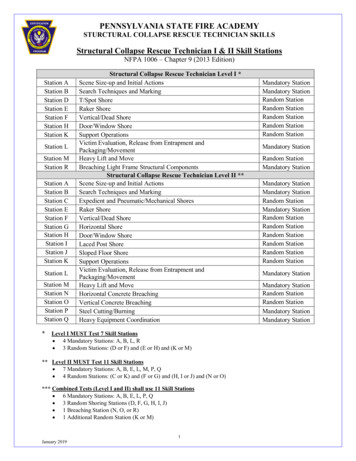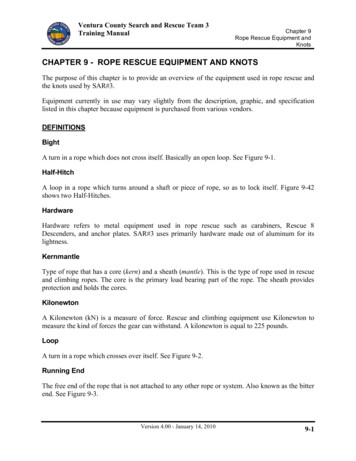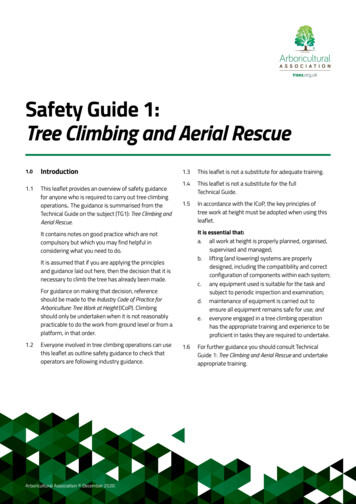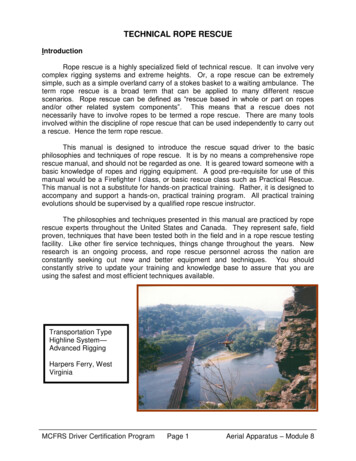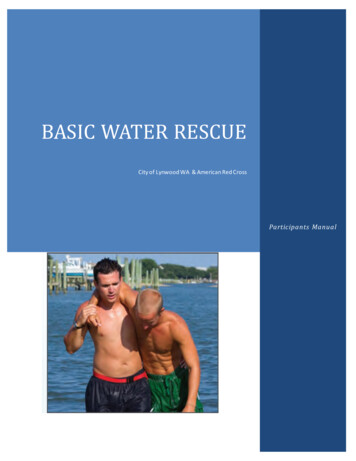
Transcription
BASIC WATER RESCUECity of Lynwood WA & American Red CrossParticipants Manual
Chapter 1: Preventing Accidents and Injuries In, On and Around the WaterLowering the Risk for Drowning -------------------------------- 2Using Life Jackets -------------------------------------------------- 7Staying Safe from Environmental Hazards ------------------ 9Staying Safe in Specific Aquatic Environments ----------- 15Staying Safe While Engaging in Water Activities --------- 27Chapter 2: Recognizing and Responding to Aquatic EmergenciesRecognizing an Emergency -----------------------------------Responding to an Emergency --------------------------------Basic Water Rescue: Helping Others in an Aquatic Emergency --------------------------------------Basic Water Rescue: Helping Yourself in an Aquatic Emergency -------------------------------------1 Pa ge36384145
2 Pa ge
The American Red Cross and Water SafetyIt is the mission of the American Red Cross to prevent, prepare for and respond to emergencies.Today, the American Red Cross Swimming and Water Safety program helps fulfill that mission byteaching people to be safe in, on and around the water through water safety courses, waterorientation classes for infants and toddlers and comprehensive Learn-to-Swim courses for people ofdifferent ages and abilities.The American Red Cross has a long history ofhelping people to be safe in, on and aroundthe water. In the early 1900s, Wilbert E.Longfellow, the Commodore in Chief of NewYork City’s newly formed U.S. Volunteer LifeSaving Corps, identified the need for anationwide program of swimming andlifesaving instruction and presented a plan forthe “waterproofing of America” to theAmerican Red Cross in 1912. Soon after, theRed Cross Life Saving Corps (forerunner ofthe present-day Red Cross Water Safetycourses) was created. Longfellow wasappointed to organize the new lifesavingprogram and was awarded the very first RedCross Lifesaving Certificate and the lifesavingemblem that has since been earned andproudly worn by millions of people (Fig. 1-4).For the next 33 years, until his death in 1947, Longfellow worked tirelessly in support of thenationwide Red Cross Water Safety program. As a result of his efforts, the nation’s drowningrate was cut almost in half—from 8.8 people per 100,000 in 1914 to 4.8 in 1947—and there was atremendous upsurge in the popularity of swimming, boating and other water activities, to the pointwhere nearly 80 million Americans were participating in some form of aquatic recreation.Water Safety Education and Learning to SwimWhile aquatic environments and activities are a great source of enjoyment, they are associated withsome risks, most notably that of drowning (the process of experiencing respiratory impairment fromsubmersion or immersion in liquid). Drowning can be fatal or nonfatal. Death by drowning is aleading public health problem in the United States and throughout the world, but the majority ofdeaths by drowning can be prevented (Box 1-1).3 Pa ge
There are two keys to lowering the risk for drowning: water safety education and knowing how toswim.Water Safety EducationWater safety education seeks to give people the knowledge they need to recognize potential risksposed by aquatic environments and activities and teaches them strategies they can use to lowerthose risks (Fig. 1-1). Water safety education also teaches people personal survival and waterrescue skills, which can improve the chances for a positive outcome should an aquatic emergency,occur. Research provides evidence of a strong link between water safety education and a reductionin drowning deaths.Learning How to SwimKnowing how to swim is a basic life skill that everyone should possess (Box 1-2). Learning how toswim if you do not already know how can help you to feel more confident when you are in andaround water and it will open up a whole new world of opportunities for enjoying water-basedrecreational activities. But more importantly, knowing how to swim can save your life or someoneelse’s life.1 Pa ge
Lowering the Risk for DrowningIn the United States, drowning ranks fifth among the causes of death from unintentional injury.And, even when a drowning incident does not result in death, it can result in significant long-termdisability. Drowning happens quickly and suddenly. Lowering the risk for drowning requires followinggeneral principles of water safety (Box 2-1) and establishing layers of protection (Fig. 2-1). Havinglayers of protection in place provides “backup” if one protective strategy fails, reducing overall risk.The American Red Cross has established five layers of protection for lowering the risk for drowning:1. Learn swimming and water safety survival skills.2. Swim ONLY in lifeguarded areas.3. Have children, inexperienced swimmers and boaters wear U.S. Coast Guard-approvedlifejackets.4. Provide close and constant supervision to children who are in or near the water.5. Fence pools and spas with adequate barriers to prevent unsupervised accessAge is a major risk factor for drowning incidents. In the United States, drowning ranks second,behind motor vehicle crashes, as a cause of death from unintentional injury in children ages 1–14;Children between the ages of 1 and 4 years have the highest rate for drowning. Most of theseincidents occur in home swimming pools, but any source of water, including a bathtub or partiallyfilled bucket, is a potential drowning hazard. An infant can drown in as little as 1 inch of water.Box 2-2 contains tips for lowering the risk for drowning for children2 Pa ge
The City of Lynnwood offers many different Safety courses – from CPR toBabysitting. Pet First Aid and CPR to wilderness First AidVisit www.playlynnwood.com or stop by Customer Service to learn more3 Pa ge
4 Pa ge
School-age children often have the opportunity to attend day trips to aquatic facilities that areorganized and hosted by a school or community group. In addition, many parents enroll their schoolage children in summer camps, where water activities may be a major attraction. In these situations,parents may not be present to directly supervise their children, so it is important for parents toevaluate the host organization’s attention to, and provisions for, aquatic safety (Box 2-3).While pools are a source of danger for younger children, a large number of drowning accidentsinvolving older children, teens and young adults take place in natural bodies of water. Thepercentage of drowning incidents in natural bodies of water increases with age, with more than halfof all the victims in these incidents being 15 years of age and older. Nearly every community hassome type of natural body of water, such as a canal, pond, creek, stream, river, lake, drainage basin,reservoir, wetlands area or shoreline that can be accessed easily. In many communities, these areasare frequently features of public parks. Easy access to natural water environments, combined withthe growing independence of older children and adolescents, can make these environmentsespecially dangerous to children who are old enough to explore on their own (Fig. 2-2). For thisreason, it is important to teach older children and teens about the dangers natural bodies of water inthe community present, and to make and enforce rules related to visiting these areas. Also, be5 Pa ge
aware that aquatic emergencies do not always happen when people are swimming. A hike along amountain stream or a canoe-camping trip poses just as much risk for an aquatic emergency todevelop.6 Pa ge
Using Life JacketsLife jackets, also known as personal flotation devices (PFDs), are not just for boaters. Youngchildren, weak or inexperienced swimmers and nonswimmers should also wear life jacketswhenever they are in, on or around the water. Life jackets are available in many styles and for manydifferent activities. The U.S. Coast Guard has categorized PFDs into five types according to theirbuoyancy and purpose.Types I, II, III and V are referred to as life jackets because they are worn on the body, whereas typeIV is a throwable device. When choosing a life jacket, select one that has been approved by the U.S.Coast Guard. PFDs that have been approved by the U.S. Coast Guard will have an approval labelstamped directly on the device (Fig. 2-3). In addition, consider swimming ability, the planned activityand the water conditions. Type II and type III life jackets are most often used in pool, waterpark andwaterfront settings.Before using a life jacket, make sure that it fits properly. Life jackets are sized according to weight. Aproperly fitted life jacket feels comfortably snug. Also check to make sure that it is in good condition.7 Pa ge
Check any buckles or straps to make sure that they function properly and look closely for any rips,tears or holes. Discard any life jacket with torn fabric or straps that have pulled loose. Test the lifejacket in shallow water and see how it feels. Practice swimming with it. Then relax and let your headtilt back. Notice if the device can keep your chin above water, allowing you to breathe easily. The lifejacket should not ride up on your body in the water.Water wings and items designed for water recreation (such as inner tubes and inflatable rafts) arenot designed or tested for safety and cannot be used as a substitute for a U.S. Coast Guardapproved life jacket and adult supervision (Fig. 2-4). In fact, these pool toys may actually increase anon-swimmer’s or an inexperienced swimmer’s risk for getting into a dangerous situation in thewater, by giving the swimmer a false sense of security. For example, the swimmer may move intowater that is too deep, fall off the toy and into the water, or the toy may overturn, setting up thepotential for a drowning situation.8 Pa ge
Staying Safe from Environmental HazardsMany aquatic activities provide a great opportunity to get outside and enjoy fresh air and sunshine.Make sure your experience stays enjoyable by being aware of environmental hazards and takingsteps to protect yourself from them.Sun OverexposureOverexposure to the sun has been linked to multiple health problems, including painful sunburns,skin cancer and eye damage (such as cataracts), and can cause premature aging and wrinkling ofthe skin. Everyone, regardless of age or skin color, is advised to take steps to limit overexposure tothe sun, such as wearing protective clothing, seeking shade when the sun’s rays are strongest andconsistently using a broad-spectrum sunscreen.Energy from the sun is called solar radiation. Solar radiation reaches the Earth in a range ofwavelengths or rays. Some of these rays are blocked by the atmosphere, but ultraviolet A (UVA) andultraviolet B (UVB) rays are able to penetrate the atmosphere and reach the Earth’s surface. In thepast, the ozone layer of the atmosphere offered more protection from dangerous UV rays, but thislayer is becoming depleted, permitting greater amounts of UV radiation to reach the Earth’s surface.Worldwide efforts are being made to stop the production of chemicals that have contributed tothinning of the ozone layer. The current belief is that with full compliance with these efforts, theozone layer can return to normal levels by 2050. However, people living and growing up during thistimeframe will live most of their lives with increased levels of UV radiation. It is overexposure to UVAand UVB rays that can lead to skin cancer and other health problems.Skin cancer is the most common type of cancer in the United States, and it is reaching epidemicproportions. According to the American Academy of Dermatology, current estimates are that one infive Americans will develop skin cancer. Despite these statistics, skin cancer is one of the mostpreventable types of cancer. Of the different types of skin cancer, melanoma is the most serious andalso one of the fastest growing types of cancer in the United States. The major risk factor formelanoma is exposure to UV light, and dermatologists think that sunburns experienced in childhoodmay lead to melanomas later in life. Non-melanoma skin cancers, including basal cell carcinomasand squamous cell carcinomas, are less deadly than melanomas but can be disfiguring and causemore serious health problems if left untreated.9 Pa ge
One of the most important actions you can take to reduce your risk for health problems as a result ofsun overexposure is to use sunscreen regularly and properly Choose a sunscreen labeled “broadspectrum” (this means it will provide protection against both UVA and UVB rays) that has a sunprotection factor (SPF) of at least 30. Apply the recommended amount of sunscreen to all exposedskin at least 15 minutes before you go outside, even if it is cloudy out (it is still possible to burn on acloudy day). Be sure to remember commonly missed areas, such as the lips, ears and the tops ofthe feet. Reapply sunscreen every 2 hours and after swimming or sweating. Use sunscreen everyday, even if you are not going to be outside for long. The sun’s rays can also damage your skinthrough the windows of a building. Box 2-4 summarizes the actions you can take to protect yourselfand your family from sun overexposure.Box 2-4Safe Fun in the Sun Use sunscreen regularly and properly. Generously apply a broad-spectrum sunscreenwith a sun protection factor (SPF) of at least 30 in ample amounts to all exposed skin 15minutes before going outdoors, even on cloudy days and even if you do not intend to beoutdoors for long. Reapply every 2 hours and after swimming or sweating. Be aware thatIllnessessunscreen is not recommended for babies younger than 6 months. If aHeat-relatedbaby younger6 monthsis outside,it is bestto theprotectbabyfromsun by coolHeat-relatedillnessesthancan occuron hot,humid dayswhenbodytheis notableto hingandbykeepingherintheshade(foritself through sweating. As a result, the body temperature rises and serious illness can troller).IfyoudochoosetoapplyAlthough it might seem hard to believe that you can overheat while in the water, it can andsunscreento a babyillnessesyoungeroccurthan 6whenmonths,onlya smallamountto thebaby’sdoes happen.Heat-relatedfl uidapplyis lostduringheavysweatingandis notfaceandthebecauseback of herreplaced.Justyouhands.are in the water does not mean that you are not sweating, particularlyif you are playing or exercising! Working hard or exercising in the heat also increases a person’sWear protectiveclothing, suchas Anda wide-brimmedhat andsunglasses,whenpossible.risk for developinga heat-relatedillness.sometimes, justbeingout in the heatandhumidityChoose99–100% protection against UV rays. If the temperature isfor a longperiodsunglassesof time canthatbe aofferproblem.nottoo warm,strategylong-sleevedshirts and pants can offer some protection from the sun too.The bestpreventionfor heat-relatedillnesses is to stay properly hydrated (Fig. 2-6). Payattentionto tothemakeUV Indexto helpyou plan your outdoor activities in ways that preventStayinghydratedhelpssure thefl uidsoverexposuretothesun.TheNationallost from sweating are replaced, which keeps Weather Service calculates the UV Index daily formostinziptheandUnitedStates, predicting the level of solar radiation expectedfl uid levelsthecodesbody e,body tissues what they need to function well. using a scale from 0 to 11 . A UV Index of 0 to 2low riska UV Index of 8 or higher indicates a very high risk.Water isindicatesthe bestachoiceof whereasfl uid for stayinghydrated, but commercial sports drinks, fruit orPaythe time of Drinkday. Thesun’s rays are strongest between 10 a.m. and 4 p.m.juicesmilkattentionare alsotoacceptable.a fewDuringthesehours,avoidexposuretoounces every 15–20 minutes or however muchthe sun or seek shade, if possible. Follow theShadowRule:WatchTheYourShadow.No Shadow, Seek Shade!you needto not feelthirsty.feelingof thirstmeans that the body is already dehydrated. gulpingKnow thatwater,sandand Smallsnow reflect the sun’s rays, increasing exposure and the riskAvoiddownfl uidsquickly.amountsfortakensunburn.in slowlyAvoidworksunbesttanning and tanning beds. If you want to look like you have beenin the sun, use a self-tanning product. Be aware that self-tanning products do not offerprotection from the sun so you will also need to use sunscreen. Eat foods high in Vitamin D rather than using the sun to get this vitamin. Early detection of skin cancer can save your life. Visit a dermatologist for an annual skinexam, and examine all of your skin yourself once a month. Have any new or changingmoles evaluated by a dermatologist.10 P a g e
Heat-related IllnessesHeat-related illnesses can occur on hot, humid days when the body is not able to effectively coolitself through sweating. As a result, the body temperature rises and serious illness can result.Although it might seem hard to believe that you can overheat while in the water, it can and doeshappen. Heat-related illnesses occur when fluid is lost during heavy sweating and is not replaced.Just because you are in the water does not mean that you are not sweating, particularly if you areplaying or exercising! Working hard or exercising in the heat also increases a person’s risk fordeveloping a heat-related illness. And sometimes, just being out in the heat and humidity for a longperiod of time can be a problem.The best prevention strategy for heat-related illnesses is to stay properly hydrated. Staying hydratedhelps to make sure the fluids lost from sweating are replaced, which keeps fluid levels in the bodybalanced and gives body tissues what they need to function well. Water is the best choice of fluid forstaying hydrated, but commercial sports drinks, fruit juices or milk are also acceptable. Drink a fewounces every 15–20 minutes or however much you need to not feel thirsty. The feeling of thirstmeans that the body is already dehydrated.Avoid gulping down fluids quickly. Small amounts taken in slowly work bestThere are three types of heat-related illnesses, of increasing severity: Heat cramps are painful muscle spasms, usually in the legs and stomach. Heat cramps canquickly turn into heat exhaustion or heat stroke. Heat exhaustion occurs when the body’s cooling system is not able to keep up. Theperson’s skin may be cool and moist, and either very pale or gray, or red. The person maybe sweating heavily and may complain of a headache, nausea or dizziness. The person mayfeel very weak or exhausted. Heat stroke is the most severe form of heat-related illness. It occurs when the body’scooling system is completely overwhelmed and stops functioning properly. Heat stroke is lifethreatening! The person’s skin will be red and hot, and it may be moist or dry. The personmay seem confused, have changes in consciousness or lose consciousness. Breathing maybe rapid and shallow, and the pulse may be rapid and weak. The person may vomit.When a heat-related illness is recognized in its early stages, it usually can be reversed. Move theperson to a cooler environment with circulating air. Loosen or remove as much clothing as possible;apply cool, wet cloths and fan the person. If the person is conscious and able to swallow, give smallamounts of a cool fluid such as a commercial sports drink, fruit juice, milk or water.If the person’s condition does not improve or you suspect heat stroke, call 9-1-1 or the localemergency number immediatelyIf the person becomes unconscious, be prepared to give CPR.HypothermiaIn hypothermia, the body is not able to keep itself warm and the body temperature falls far belownormal. Hypothermia can lead to death if it is not treated. In an aquatic setting, hypothermia canresult from exposure to cold water or air temperatures, or both. The air or water temperature doesnot have to be below freezing for hypothermia to occur. This is especially true if a person is wet andthere is wind. For example, a child who is wet from swimming could develop hypothermia, even inthe summertime!Children and older adults are particularly susceptible to hypothermia. Environmental conditions andprolonged exposure to water or wet clothing (which speeds up the rate at which body heat is lost)can also increase susceptibility to developing hypothermia—even during the summer or in indoor11 P a g e
facilities. Immersion in cold water (for example, as a result of breaking through ice, falling off a pieror being thrown into the water from a boat) also puts a person at risk for hypothermia.Box 2-5 summarizes actions you can take to lower the risk for developing hypothermia whenengaging in aquatic activities.Box 2-5Lowering the Risk for Hypothermia Avoid being outdoors during the coldest part of the day.Be aware that many people who fall into cold water never intended to go into the waterin the first place.Whenever you are near cold water (for example, playing, working, hunting or fishing),remember that cold water can be dangerous, and take the appropriate precautions.o In cooler weather, wear an outer layer that is water-resistant and breathable, awarm hat, and lightweight layers of clothes or insulated clothes.o Avoid cotton, which traps moisture. Instead, wear wool or synthetic blends,which help to move moisture away from the skin.o Know that clothing can help you float and stay warm if you fall into the water.o If you are in a remote area, carry matches in a waterproof container. It may benecessary to build a fi re to warm up after a fall into cold water.Always wear a U.S. Coast Guard-approved life jacket while boating in cold water.Wear a wet suit for skin diving, surfing and kayaking, or other activities that take placein the open water or involve repeated submersion.Only participate in aquatic activities when and where it is possible to get help quickly inan emergency.Drink warm fluids that do not contain alcohol or caffeine to help the body maintain anormal temperature.Although alcohol may temporarily make you feel warmer, it actually increases loss ofbody heat and susceptibility to hypothermia.Inclement WeatherWeather conditions can change suddenly. Always check the weather forecast before heading out,and know what to do in case inclement weather suddenly arises. You can learn about different kindsof weather events, and how to be prepared for them, by visiting the American Red Cross website(www.redcross.org).ThunderstormsElectricity and water do not mix! Leave the water at the first sound of thunder or sight of lightning.Remember the 30/30 rule: take cover when the time between a flash of lightning and a roll ofthunder is 30 seconds or less, and remain under cover until 30 minutes after the last flash oflightning was seen or the last roll of thunder was heard. If you are outside and cannot reach safetyinside of a building, look for a low area. Avoid high ground, tall trees that stand alone, and structuressuch as sheds, dugouts, bleachers and picnic pavilions. These areas are not safe in a thunderstorm;if no safe shelter is available, squat with your feet together and your arms wrapped around your legs.You want to stay low, but you do not want to lie flat; the less of your body that is in contact with theground, the better.FloodsFloods are among the most common water hazards that occur in the United States. Anywhere itrains, it can flood. Being aware of local flood hazards is important for everyone, but especially for12 P a g e
people who live near water, in low-lying areas, behind a levee or downstream from a dam. Floodingoccurs when waterways such as rivers or streams overflow their banks. It can also occur whenrainfall or snow melt exceeds the capacity of underground pipes or drains designed to carryfloodwater away from urban areas. Some floods build gradually over a period of days, but flashfloods can develop within minutes or hours without any obvious signs of rain. They often producepowerful and destructive walls of water and debris.When a flood watch or warning is in effect, head to higher ground and stay away from the water. Ifemergency officials advise evacuation, do so immediately. Remember the motto, “Turn around, don’tdrown!” According to the National Weather Service, most of the fatalities during flood events resultfrom people attempting to drive or walk on flooded roadways. It only takes 18 inches of water to lift avehicle. Once a vehicle becomes buoyant, the water will easily push it sideways and could cause itto tip over. If you are trapped in a car on a flooded road, abandon the car immediately and move tohigher ground. Use extreme caution when walking through floodwaters. Six inches of swiftly movingfloodwater is enough to knock you off your feet.Avoid natural bodies of water for 24 hours after heavy rains and flooding, because runoff cancontaminate the water with toxic substances. Pay particular attention to children. They are curiousand lack judgment about flood-related hazards, such as swiftly moving water and contaminatedwater.Recreational Water IllnessesA recreational water illness (RWI) is an illness that is spread by swallowing, breathing orcontacting contaminated water. A person can contract an RWI from a natural body of water or fromthe chlorinated water found in pools and waterpark attractions. In fact, pool water is a very commonsource of RWIs, especially common ones such as diarrhea, earaches and rashes. In rare cases,RWIs can cause pneumonia, neurological damage and even death.In a swimming pool or waterpark setting, water contaminated by feces is a primary source of RWIs.Vomit and blood are less likely to cause RWIs. Look for clues to water quality before you get in thewater—the pool water should be clean and clear with little or no odor. You should be able to clearlysee the main drain on the bottom of the pool, and there should not be a strong chemical odor in theair. Visually inspect surfaces. Pool tiles and attractions such as waterslides should not be sticky orslimy. Lastly, ask the facility staff about the facility’s protocols for maintaining water quality,conducting health inspections and training staff members about water quality.You may also be able to obtain information about water quality in some natural settings, such as atthe ocean or lake. Many guarded beaches are tested regularly for pollution and disease causingorganisms. In some areas, water quality flags give information about water conditions. For example,blue flags indicate good swimming conditions and red flags indicate a potential water qualityproblem.DiarrheaDiarrhea is the most commonly reported RWI. When a person with diarrhea swims, the waterbecomes contaminated. A person who swallows the contaminated water could also then become ill.To lower the risk of infection for others, a person who has diarrhea should not enter the water. TheCenters for Disease Control and Prevention (CDC) has developed six “PLEAs” to promote safe andhealthy swimming in pools and at waterparks (Box 2-6).13 P a g e
When a young child who still wears diapers will be in the water, many facilities require that the childwear swim diapers. Swim diapers are specifically designed to be worn in the water. They are waterresistant and fit snugly around the child’s waist and legs. However, if a child has a bowel movementin the diaper, there is still risk for stool escaping and contaminating the water. For this reason, it isimportant to take frequent breaks to check and change the diaper. A contamination incident involvingfeces or vomit that contains solid matter or food particles requires staff to implementdecontamination procedures. These procedures include evacuating the pool, removing any solidmatter, increasing the chlorine level and maintaining the elevated chlorine level for a set period oftime before reducing the chlorine level to its normal level and reopening the pool. For an incidentthat involves vomit or formed stool, the pool must remain closed for 25 minutes. For an incident thatinvolves diarrhea, the pool must remain closed for 13 hours.Swimmer’s EarSwimmer’s ear, an RWI that most often affects children, occurs when water remains in the externalear canal for a prolonged period of time. The water usually is contaminated by organisms found inpools and other water environments. The trapped water allows these organisms to grow in the earcanal, causing irritation and infection. Signals of swimmer’s ear typically begin within a few days ofswimming and may go away, on their own & without treatment; however, painful, swollen or fullfeelings in the ear or even slight hearing loss are reasons to see a health care provider. Thesesignals could indicate a more serious inner ear infection. Box 2-7 contains tips for prevention.14 P a g e
Staying Safe in Specific Aquatic EnvironmentsThroughout the course of a lifetime, a person may have the opportunity to engage in and enjoyaquatic activities in a variety of settings. Every aquatic setting poses specific safety challenges.Being aware of these safety challenges can help you stay safe no matter what aquatic setting youare in.Swimming Pools and Hot TubsSwimming pools and hot tubs may be open tothe public or privately owned by homeowners.Public pools and hot tubs include those foundin recreation and fitness centers, hotels andmotels, and multi-unit housing complexes.Some public pools and hot tubs aresupervised by lifeguards and others are not.Box 2-8 summarizes important tips for stayingsafe for anyone visiting a public pool or hottub.Home (residential) swimming pools and hottubs are an attractive fea
American Red Cross in 1912. Soon after, the Red Cross Life Saving Corps (forerunner of the present-day Red Cross Water Safety courses) was created. Longfellow was appointed to organize the new lifesaving program and was awarded the very first Red Cross Lifesaving Certificate

